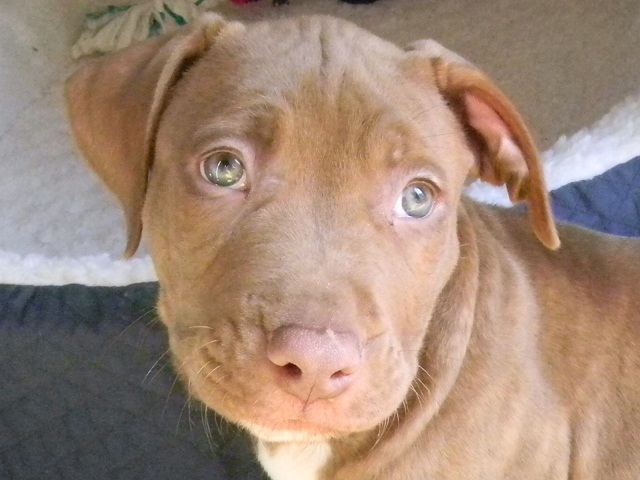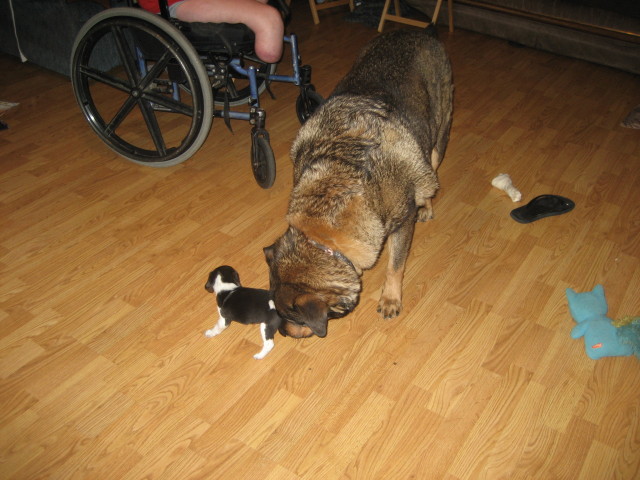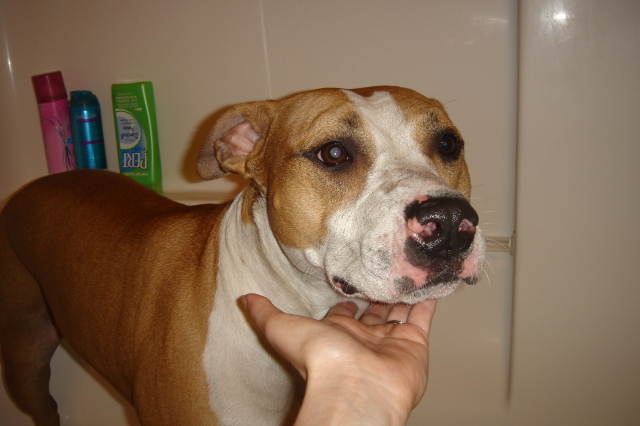QuestionI HAVE A 5 YEAR OLD HUNGARIAN VIZLA DOG WE HAVE BEEN DOING BUILDING WORK ON OUR HOUSE FOR THE LAST 8 YEARS ON & OFF. RECENTLY HE HAS BECOME VERY SCARED OF THE NOISES IN PARTICULAR THE NAIL GUN OR SHOULD I SAY THE COMPRESSOR TO THE POINT I LEFT HIM IN THE HOUSE FOR ABOUT AN HOUR ON HIS OWN & HE WAS THAT SCARED HE POOED & WEED HOW CAN I HELP HIM OVER THIS FEAR AS WE HAVE JUST BOUGHT ANOTHER HOUSE & IM WORRIED ABOUT LEAVING HIM WHEN I GO TO WORK
AnswerDear Andrea,
Thank you for writing to me about your 5 year old Hungarian Vizla. I appreciate your patience in waiting for my response to your question.
Since you have been working on your house for the last eight years I would assume that your dog has always been exposed to construction noise so in his short life, this is really not new for him.
I am assuming also, that something negative happened to him that he now associates with the sound of the nail gun and compressor (cause and effect). It is important that either he be removed from the premises while further construction is taking place or that you try to desensitize him to the noise.
THE FEARFUL DOG
Dogs may display a variety of behaviors when they're afraid. A fearful dog will display certain body postures, including lowering his head, flattening his ears back against his head, and tucking his tail between his legs. He may also pant, salivate, tremble and/or pace. A frightened dog may try to escape, may show submissive behaviors (avoidance of eye contact, submissive urinating, rolling over to expose his belly), or he may freeze and remain immobile. Some dogs will bark and/or growl at the object that is causing their fear. In extreme cases of fearfulness a dog may be destructive (out of general anxiety or in an attempt to escape), or he may lose control of his bladder or bowels and, therefore, house soil.
CAUSES OF FEARFUL BEHAVIOR
Determining why your dog is fearful isn't always
essential to treating the fearful behavior, although the reason for his fear will dictate the relative success of the treatment. A dog that is genetically predisposed to general fearfulness, or a dog that was improperly socialized during a critical stage in his development, will probably not respond as well to treatment as a dog that has developed a specific fear in response to a specific experience. It's essential, however, to first rule out any medical causes for your dog's fearful behavior. Your first step should be to take your dog to your veterinarian for a thorough medical evaluation, especially his thyroid.
WHAT CAN YOU DO?
Most fears won't go away by themselves, and if left untreated, may get worse. Some fears, when treated, will decrease in intensity or frequency but may not disappear entirely. You may need help from a professional animal behavior specialist to help you with these techniques.
DESENSITIZATION
Begin by exposing your dog to a very low level or small amount of whatever it is that's causing his fear.
Reward him for calm, non-fearful behavior. As long as your dog remains relaxed, reward him with treats and praise. If at any point he becomes anxious, move the item in question away and proceed at a slower pace.
When your dog can remain relaxed , gradually increase the proximity of the object of fear, rewarding your dog for remaining calm and relaxed. Repeat this procedure as many times as necessary.
This process may take several days, weeks or even months. You must proceed at a slow enough pace that your dog never becomes fearful during the desensitization process.
DESENSITIZING YOUR DOG TO NOISE:
As with most fear issues, you need to employ something called "Classical Conditioning." It takes the fear of noise and turns the fear into anticipation.
What you need to do is start with placing your dog near the compressor and feeding him there. Play with him and give him treats. Let him start to associate the physical compresesor with good experiences. Encourage your dog to get near the compressor. If pooch even gets near the compressor, give a treat. If your dog even looks at the compressor, tell pooch how good he is and give a treat. When your dog is comfortable standing by the compressor, move on.
Then, gently try to encourage your dog to sit, touching the compressor. If pooch does it, treats and lots of praise. Continue this until your dog is happily incorporating the compressor into his everyday life.
Then, turn the compressor on in the other room. Repeat all the previous steps again and again until there's no hesitancy to move closer to the room with the compressor on. Praise. If your dog even looks at the door/room, treat and praise. When you can get your pooch comfortabley standing near the door to the room, move to the next step.
Turn the compressor on. Again, if your dog even gets near the doorway, treat and praise. If your dog looks at the door, same thing. Continue with the similar steps above until fido is comfortable.
All of this should take you weeks if not months to progress through. Do not expect to get your dog classically conditioned in a few days or a few sessions. Slow. Slow. Slow. If your dog is balking to much, you're moving too fast.
What Classical Conditioning does is take your dog's fear of noise and turns it into anticipation. Your dog will hear the compressor and think, "treats!" It turns a bad into a good.
Also, you can use a clicker to do this much more easily. Get a book on clicker training and learn how to use a clicker with classical conditioning. You can find several books on clicker training at any bookstore or on-line at Amazon.com or at jandjdogs.com or cleanrun.com
If you follow these suggestions slowly and with a positive attitude, I think that you can turn your dog's attitude around so that you can both enjoy your time together.
You can also add an anxiety wrap (www.sitstay.com) to the mix.
You can also use Rescue Remedy in his water bowl (12 drops) and rub some on her gums during the day. This will take some of the edge off his anxiety.
Giving him Melatonin could be the answer to this issue. An effective treatments for phobias (and general anxiety) is melatonin, an over-the-counter hormone used by humans to treat insomnia.
Dr. Nicholas Dodman and his colleague Dr. Linda Aronson of the behavioral section at Tufts New England Veterinary Medical Center had been looking for something that would help reduce canine thunderstorm phobias when they discovered research papers on the effect of melatonin. Research indicated a positive effect of melatonin on dogs that continually lick their flanks as well as a calming effect on chickens in overcrowded conditions.
Drs. Dodman and Aronson wondered whether melatonin might work on noise phobic dogs. The first dog to try it was Dr. Aronson's own Bearded Collie who had severe thunder phobia after lightening struck very near her house. The effect of the melatonin was dramatic. The dog simply stopped being afraid instead of tearing around the house and digging at the carpets. The melatonin did not put her to sleep, she stayed awake and alert -- just not bothered by the thunder.
Drs. Dodman and Aronson then gave the melatonin to other dogs and produced the same result. Melatonin worked for other noise fears (one dog was afraid of songbirds) as well, including fireworks!
Melatonin is sold in capsules and tablets in health food stores, pharmacies and some supermarkets. It is sold in doses as low as 200 micrograms (mcg.). For most dogs, Aronson prescribes 3 milligrams (mg.) In a few cases, dogs weighing over one hundred pounds needed 6 mg. but that was unusual. Aronson usually gives dogs that weigh less than 30 pounds, 1.5 mg. Although they have not treated any phobic really tiny dogs, Aronson would reduce the dosage further for them.
It's important to read the labels on melatonin bottles very carefully. Some are mixed with herbs or nutrients that may not be safe for dogs. Make sure you buy the correct dosage for your size dog. Remember, there are 1,000 micrograms (mcg.) in a milligram (mg.) so a 200 mcg. pill contains only 1/15 of the amount recommended for a large dog.
Because melatonin is not regulated by any federal agency, the quality varies greatly from manufacturer to manufacturer. If an inferior product is administered, it may not be effective in calming a dog whereas a higher quality product might be. Purchase the product from a supplier you trust and believe in. Some holistic veterinarians sell melatonin and their products might be better quality.
Melatonin remains effective for several hours. Give melatonin immediately when you see your dog becoming agitated. If your dog has automimmune disease or severe liver or kidney disease, check with your veterinarian before giving melatonin.
Some pet owners have alleviated their dog's anxiety by dispensing Calm Pet by NutraBest/Natural Pet Nutrition which contains valerian, chamomile, kava kava, St. John's wort and melatonin.
Best Regards,
Shelley Davis
FOLLOW UP:
Dear Andrea,
Please be advised that giving dogs Melatonin is vet advised and isn't considered to be harmful. I am not sure where you found information to the contrary but be rest assured, it can be perscribed by your vet. You can also ask your vet to perscribe a form of doggie xanax.
I hope this helps.

 10 week old Pitbull Pup
Question
Ares
I have a few questions =]
Why does he ke
10 week old Pitbull Pup
Question
Ares
I have a few questions =]
Why does he ke
 Getting a puppy and dog to get along
Question
RC and Kayleigh
Last Tuesday our dog for 14 ye
Getting a puppy and dog to get along
Question
RC and Kayleigh
Last Tuesday our dog for 14 ye
 Live worms came out in my dogs poop and he has some rashes?
Question
The Rashes
She is 15 months old and is
Live worms came out in my dogs poop and he has some rashes?
Question
The Rashes
She is 15 months old and is
 Gnawing/ Uncontrollable Itch
Question
Burgess
My wonderful dog Burgess, A Dac
Gnawing/ Uncontrollable Itch
Question
Burgess
My wonderful dog Burgess, A Dac
 Dog breed?
QuestionQUESTION: Hi Nancy,
I am attaching an image of
Dog breed?
QuestionQUESTION: Hi Nancy,
I am attaching an image of